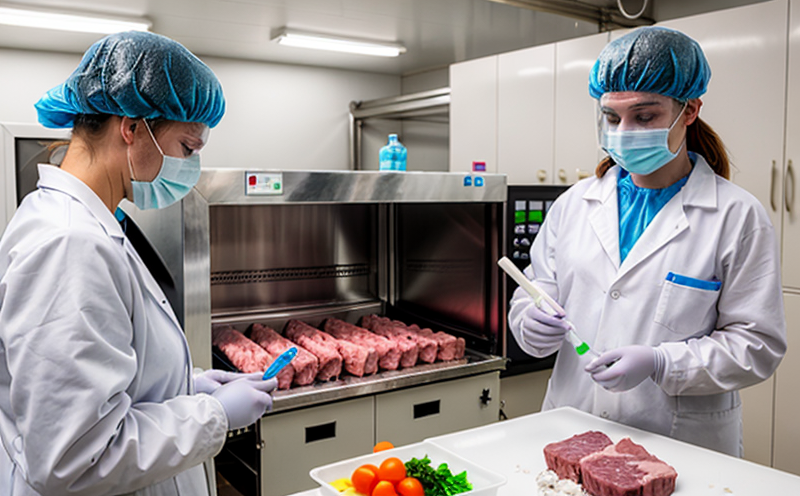EN 8015 Microbial Contaminant Testing in Dairy and Meat
The European Standard EN 8015 provides a comprehensive framework for assessing microbial contamination levels in dairy products and meat. This standard is crucial for ensuring food safety, quality assurance, and compliance with international regulatory requirements.
Microbial contaminants can significantly impact the shelf life, safety, and consumer perception of dairy and meat products. Compliance with EN 8015 is essential for maintaining market access and consumer trust. The methodology outlined in this standard ensures consistent and accurate microbial testing across different environments and product types.
The process begins with sample collection, which must be performed following strict guidelines to avoid contamination. Samples are then processed using standardized methods that include homogenization, dilution, and plating techniques. This step is critical for obtaining representative samples that accurately reflect the microbial content of the product.
After sample preparation, testing can commence. The standard specifies a range of tests including aerobic plate count (APC), total viable count (TVC), coliform group determination, and other relevant indicators specific to dairy or meat products. Each test is designed to identify potential pathogens such as Salmonella, Listeria monocytogenes, and Escherichia coli.
The choice of media and incubation conditions plays a vital role in the accuracy of results. For instance, enrichment broths are used for pathogen recovery, while selective media help isolate specific organisms like coliforms or Salmonella. Incubation periods vary depending on the organism being tested; typically, they range from 24 to 72 hours.
Once colonies have formed, they undergo further identification through biochemical tests or molecular techniques such as PCR (Polymerase Chain Reaction). These methods ensure precise differentiation between similar appearing microorganisms. The final step involves calculating the microbial load based on colony-forming units per gram or milliliter, depending on the sample type.
Compliance with EN 8015 not only enhances product safety but also supports sustainable practices by minimizing waste and improving resource efficiency within production processes. By identifying early signs of contamination, producers can implement corrective actions promptly, reducing losses associated with spoilage or recalls.
In conclusion, adhering to EN 8015 ensures robust quality control measures that protect both consumers' health and the reputation of manufacturers in the dairy and meat industries. It demonstrates a commitment to excellence and transparency which are increasingly valued by modern consumers seeking trustworthy brands.
Industry Applications
The application of EN 8015 is widespread across various sectors within the food industry, particularly focusing on dairy products and meats. Dairy manufacturers use this standard to monitor raw materials before processing, ensuring that only safe and hygienic ingredients enter their production lines.
For meat processors, compliance helps maintain high standards of hygiene throughout slaughterhouses and cold storage facilities. By detecting microbial contamination early, they can take necessary precautions against cross-contamination between different batches or species.
This standard also applies to importers/exporters who must prove adherence to international regulations regarding food safety. It ensures that products meet the stringent requirements set by importing countries like those outlined in Codex Alimentarius and other global standards.
Additionally, research institutions studying microbial behavior may utilize EN 8015 as a benchmark against which they evaluate new preservation techniques or additives aimed at extending shelf life while maintaining quality.
Environmental and Sustainability Contributions
Adherence to EN 8015 contributes positively towards environmental sustainability by reducing waste generation and promoting efficient resource utilization. By accurately identifying microbial contamination, industries can optimize their production processes, thereby minimizing unnecessary use of water, energy, and other resources.
The standard encourages the implementation of preventive measures aimed at eliminating sources of contamination rather than relying solely on post-harvest treatments or interventions. This approach reduces the environmental footprint associated with chemical disinfectants and preservatives commonly used in food processing.
Moreover, by enhancing product safety through rigorous microbial testing, EN 8015 supports better consumer health outcomes, leading to fewer instances of illness related to contaminated foods. Healthier populations contribute to overall societal well-being, which indirectly benefits the environment by reducing strain on healthcare systems and associated resource consumption.
In summary, compliance with EN 8015 aligns closely with broader goals of sustainable development, fostering an industry that is both responsible and forward-thinking in its approach to environmental stewardship.
Competitive Advantage and Market Impact
Compliance with EN 8015 provides significant competitive advantages for companies operating in the dairy and meat sectors. It positions them as leaders in food safety and quality assurance, thereby enhancing brand reputation and consumer trust.
Consumers are increasingly concerned about the safety and purity of their food choices. By demonstrating adherence to international standards like EN 8015, businesses can reassure potential customers that they prioritize public health and ethical practices.
This standard also facilitates easier entry into foreign markets where stringent regulatory requirements exist. For instance, countries such as Australia or New Zealand have strict import protocols for dairy products, requiring proof of compliance with relevant international standards including EN 8015.
Furthermore, adherence to this standard can lead to cost savings in the long run due to reduced risk of recalls and associated penalties. Producers who consistently meet these stringent criteria are less likely to experience disruptions caused by contaminated batches or failed audits.
In summary, EN 8015 is more than just a compliance requirement; it serves as a strategic tool for building strong brands capable of competing effectively in today’s global marketplace.





